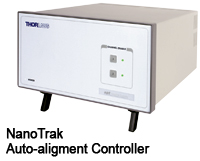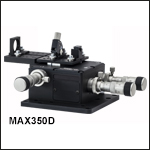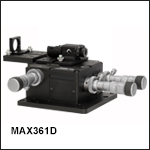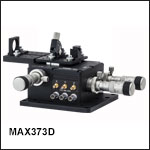Fiber Launch Systems: Professional Solutions

- NanoMax™ MAX300 Series Stages
- Precision Differential Drives
- Piezo/Stepper Motor Drives Available
- Compatible with NanoTrak® Auto-Alignment System
MAX350D
Bare Fiber
Single Mode Fiber Launch
Microscope Objectives and
Fiber Sold Separately
MAX361D
Polarization-Maintaining
Single Mode Fiber Launch
MAX373D
Single Mode
Auto-Alignment Fiber Launch
US Patents 6,186,016 and 6,467,762

Please Wait
Features
- Flexure Design Ensures Smooth, Continuous Motion with No Friction
- Compact Design: 157.4 mm x 160.4 mm x 62.5 mm (6.2" x 6.31" x 2.46") Includes Actuators
- Enhanced Long-Term Stability
- All Adjusters Tied to the Base, Minimizing Crosstalk
NanoMax Parallel Flexure Stages
The 3-Axis NanoMax™ flexure stages are ideal for fiber coupling applications. The complete fiber launch systems assembled here have been configured to meet many of the most common laboratory applications. Each launch system is fully described below. Please see the NanoMax 3-Axis Flexure Stage presentation for more specific details about the stage included in these kits.
X, Y, and Z Axes are Decoupled to Maximize Stablility During Adjustment
The patented MAX300D series stage features a parallel flexure design which has significant advantages when it is implemented in alignment applications requiring sub-micron resolution or better. Typically with a multi-axis stacked stage, touching one of the drives that is not connected to the base of the stage will result in unwanted motion within the assembly. With each of the drives on a NanoMax series stage coupled directly to the base of the stage, these adverse effects are eliminated. The fixed differential drives offer 4 mm of coarse travel as well as 300 μm of fine travel with a resolution of 50 nm per revolution. The graduations engraved on the fine travel provide a clear reference point for applications that require absolute positioning.
When considering a fiber launch system, the use of nested flexure plates in place of more traditional linear bearings provides a number of advantages. First, nearly perfect, smooth, continuous motion is achievable with a flexure mechanism. Second, a flexure mechanism eliminates the need for lubricants within the stage structure. With traditional bearings, minor imperfections in the bearing or contaminants trapped in the lubricant create localized rough spots where the displacement resolution degrades significantly. The lack of lubricants also minimizes stage creep.
Easy Alignment of Accessories
A central keyway in the top platform allows rapid system reconfiguration while maintaining accessory alignment. A wide range of accessories is available to mount items such as microscope objectives, collimation packages, wave guides, fiber and much more.
In addition, adapter plates are available to mount the NanoMax series stages to a wide range of other Thorlabs rotation and long travel linear stages.
Combined, these features make the MAX300D series flexure stages solid platforms for alignment applications that require high stability and repeatability.
Common Specifications
| Item # | MAX350D, MAX361D, and MAX373D | ||
|---|---|---|---|
| Travel | 4 mm | ||
| Load Capacity (Max) | 2.2 lbs (1 kg) | ||
| Recommended Load Capacity | <1.54 lb (<0.7 kg) | ||
| Thermal Stability | 1 µm/°C | ||
| Weight | 1.65 lbs (0.75 kg) | ||
| Deck Height | 2.46" (62.5 mm) | ||
| Optical Axis Height | 2.95" (75 mm) | ||
| Differential Adjuster Specifications | |||
| Coarse Adjustment | 0.5 mm/rev | ||
| Fine Adjustment | 50 µm/rev (300 µm Range) | ||
Arcuate Cross Talk Specifications
The table below shows the theoretical amount of cross talk to the Z axis, when a movement is demanded at various X positions (Y axis at zero).
Cross talk at Y axis positions (with X at zero) would be the same.
| X-axis position (mm) | 0.0 | 0.5 | 1.0 | 1.5 | 2.0 | 2.5 | 3.0 | 3.5 | 4.0 |
| Arcuate Motion in Z axis (µm) | 80.0 | 45.0 | 20.0 | 5.0 | 0.0 | 5.0 | 20.0 | 45.0 | 80.0 |
The table below shows the typical amount of cross talk to the X axis, when a movement is demanded at various Z axis positions (Y axis at zero).
Cross talk to Y axis positions (with X axis at zero) would be the same.
| Z-axis position (mm) | 0.0 | 0.5 | 1.0 | 1.5 | 2.0 | 2.5 | 3.0 | 3.5 | 4.0 |
| Arcuate Motion in X axis (µm) | 57.1 | 32.1 | 14.3 | 3.6 | 0.0 | 3.6 | 14.3 | 32.1 | 57.1 |
MAX373D Piezo Stage Specifications
| Item # | MAX373D | |
|---|---|---|
| Piezo Specifications | ||
| Piezo Control | Open Loop or Closed Loop | |
| Piezo Voltage Range | 0 - 75 V | |
| Piezo Range | 20 µm +0.2 µm / -0.0µm | |
| Piezo Bidirectional Repeatability | 0.05 µm | |
| Absolute On-Axis Accuracy | 1.0 µm | |
| Resonant Frequency | ||
| No Load | 375 Hz | |
| with 9.7oz (275 g) Load | 200 Hz | |
| with 20.3oz (575 g) Load | 150 Hz | |
| Compatible Piezo Controllers | BPC303 MPZ601 KPC101 MNA601/IR BNT001/IR KNA-VIS or KNA-IR |
|
Kit Specifications
| Item # | MAX350D | MAX361D | MAX373D |
|---|---|---|---|
| Fiber Diameter Range | 125 µm to 2.66 mm | 125 µm | 125 µm to 2.66 mm |
| Fiber Connector | Bare Fiber | Bare Fiber | Bare Fiber |
| Grin Lens Diameter | N/A | N/A | N/A |
| Rotator Eccentricity | N/A | 10 µm over 360 Degree Range | N/A |
| Piezo Drive Voltage | N/A | N/A | 0 - 75 V |
| Piezo Range | N/A | N/A | 20 µm |
| Piezo Bidirectional Repeatability | N/A | N/A | 200 nm Open Loop, 5 nm Closed Loop |
Choosing the correct lens or objective for launching light into a fiber depends on several factors, such as the input wavelength, beam diameter, and the mode field diameter (MFD) of the fiber. The focal length or effective focal length required to optimize coupling can be estimated using the relationship below. For specific lens and objective recommendations, please contact Technical Support.
As an example calculation, the P1-630A-FC-2 FC/PC single mode patch cable, which incorporates SM600 fiber, has an 1/e2 mode field diameter (MFD) of 4.3 μm at 633 nm. The MFD should equal the diffraction-limited spot size Øspot, which is given by the following equation:

Here, f is the focal length of the lens or effective focal length of an objective, λ is the wavelength of the input light, and D is the 1/e2 diameter of collimated beam incident on the lens.
Lenses or objectives can be used to launch light into an optical fiber. The clear aperture must be larger than the input beam diameter. For optimum coupling, the spot size of the focused beam must be less than the MFD of the single mode fiber. As a result, if a lens or objective is not available that provides an exact match, then choose an optic with a focal length that is shorter than what the calculation above yields. Alternatively, if the clear aperture is large enough, the beam can be expanded before the lens or objective, which effectively reduces the spot size of the focused beam.
| Posted Comments: | |
Jorge Negrín
(posted 2021-08-06 08:58:38.887) Hello, I have a 650nm laser to launch into fiber, D=10mm and FO SM600 with MFD 4um. Applying the equation f=48,3mm.
I would like to put a microscope objetive, could you help to me to select one.
Also i need a quotation of this and MAX361D/M
Thanks DJayasuriya
(posted 2021-08-11 03:13:44.0) Thank you for your inquiry. We will get in touch with you directly. user
(posted 2015-09-03 12:44:02.45) The pdf for the manual appears to be broken. myanakas
(posted 2015-09-03 09:18:31.0) Response from Mike at Thorlabs: Thank you for bringing this issue to our attention. The problem has been resolved and the link will now direct you to the MAX350D/M manual. Since no email address was provided we are unable to contact you directly. If you experience any further issues, please contact TechSupport@thorlabs.com. tcohen
(posted 2012-11-15 15:30:00.0) Response from Tim at Thorlabs: This will depend on your incoming source. The HC-800B has an NA of ~.20 and a MFD of 5.5um at 820nm. We would like to keep the objective NA and spot size matched to the fiber NA and MFD. As spot size = 4*lambda*f/(pi*D) and we are matching this to the MFD of the fiber, our desired focal length becomes pi*D*MFD/(4*lambda). The EFL of an objective is tube lens / magnification. For Olympus microscopes this is 180mm. Focal length for a 3mm input beam would therefore be pi*3mm*5.5um/(4*820nm) = ~15.8mm. For example, the RMS10X focal length is 180mm/10 = 18mm. I will contact you directly to further discuss these options with your source. rjgordon
(posted 2012-11-14 17:22:32.033) Which fiber launch do you recommend for the HC-800B or similar fiber? I do not anticipate the need for automated positioning. Also, which objective do you recommend for an 800 nm pulsed input? And what are the prices of each? |

| Included with the MAX350D | |
|---|---|
| MAX313D | 3-Axis Flexure Stage with Fixed Differential Drives |
| AMA009 | Fixed Angle Bracket |
| HCS013 | RMS Microscope Objective Mount |
| HFF001 | Variable V-Groove Fiber Clamp |
| HFS001 | Cable Strain Relief |
- Ideal for Bare Fiber, Lensed Fiber, or Sleeved Fibers
- V-Groove Hexagonal Holder (HFF001) Accommodates Fibers Ranging from Ø125 µm to Ø2.66 mm
- 4 mm Travel Adjustment Range
- 300 µm Fine Adjustment with 50 nm Resolution
- Suitable for any RMS-Threaded Objective (Not Included)
The MAX350D Fiber Launch System for Bare Single Mode Fiber features our high-resolution differential adjusters, which are ideal for optimizing the coupling of a free-space laser into a single mode fiber. It is capable of fiber coupling even in the visible spectrum where the mode field diameter of fiber may be as small as 3 µm. The quick-release fiber holder provides six mounting surfaces, each one designed to accept a different size fiber. The addition of a cable strain relief helps to prevent inadvertent disruption of the system. This preconfigured system is an ideal starter system, which can be quickly adapted to many uses through the use of additional flexure stage accessories.

| Included with the MAX361D | |
|---|---|
| MAX313D | 3-Axis Flexure Stage with Differential Drives |
| AMA009 | Fixed Angle Bracket |
| HCS013 | RMS microscope Objective Mount |
| HFR007 | Quick Release Fiber Rotator |
- 4 mm Travel
- High Resolution Differential Adjusters
- High Precision Fiber Rotator with 10 µm Eccentricity (Core Offset) over 360°
- Suitable for any RMS-Threaded Objective (Not Included)
The MAX361D fiber launch system, which is designed for use with bare PM fiber, is configured from our highest performing flexure stage and three of our high resolution dual stage micrometers. This combination provides both the resolution and the stability required to achieve true sub-micron positional control.
The HFR007 fiber rotator included in this package features an engraved dial with 5° increment graduations. In addition, the quick-release fiber clamp allows quick and easy top loading of the fiber. The HFR007 provides the added degree of rotational freedom that is required to optimize the extinction ratio of a PM fiber. This preconfigured system is an ideal starter system, which can be quickly adapted through the use of additional flexure stage accessories.

| Included with the MAX373D | |
|---|---|
| MAX311D | 3-Axis Flexure Stage with Differential Drives and Internal Piezos with Feedback |
| AMA009 | Fixed Angle Bracket |
| HCS013 | RMS Microscope Objective Mount |
| HFF001 | Variable V-Groove Fiber Clamp |
| HFS001 | Cable Strain Relief |
- Ideal for Bare Fiber, Lensed Fiber, or Sleeved Fibers
- Variable Hexagon-Shape Holder
- Accommodates Fibers Ranging from Ø125 µm to Ø2.66 mm
- Variable Pressure Clamping Arm
- 4 mm Travel Adjustment Range
- 300 µm Fine Adjustment with 50 nm Resolution
- Suitable for any RMS-Threaded Objective (Not Included)
The MAX373D launch system features our high resolution differential adjusters, which are ideal for optimizing the coupling of a free space laser into a single mode fiber, even in the visible spectrum where the mode field diameter of the fibers are as small as 3 µm. The quick-release fiber holder provides six mounting surfaces, each one designed to accept a different size fiber. The addition of a cable strain relief helps to prevent inadvertent disruption of the system, a small feature that can be a great time saver. This preconfigured system is an ideal starter system that can be quickly adapted to many uses.

Auto Alignment Using Internal Closed-Loop Piezoelectric Actuators
The MAX373D uses three strain gauge displacement sensors to provide a voltage signal that is linearly proportional to the displacement of the piezoelectric element. Using this signal, it is possible to compensate for hysteresis, creep, or thermal drift that is inherent to all piezoelectric elements. Additionally, the use of the displacement sensor in combination with our NanoTrak® Auto-Alignment System allows you to optimize precisely the coupling efficiency of an optical system. Then once aligned, the displacement sensors can be used to stabilize the position of the system while subsequent operations are performed. More details on the theory of operation may be found on our NanoTrak webpage. These piezo stages include three PAA100 Drive Cables and three PAA622 Feedback Converter Cables.
Fiber Alignment Bundles
We offer the stage and NanoTrak controller bundled with all associated cables. The MAX373DK1 and MAX373DK1/M are complete autoalignment kits with an InGaAs detector for IR wavelengths. A Silicon detector (NTA009) for visible wavelengths is available separately.
For applications where auto alignment is not required, the piezo actuators in the stage could be controlled by our BPC30x Benchtop Piezo Controllers.
Please note that the piezo mechanism uses contact with the micrometer drives in order to move the top platform. If for any reason the stage is operated with the micrometer drives removed, blanking plugs must be fitted before the piezo actuators can function. To order blanking plugs, please contact Tech Support.
 Products Home
Products Home













 Zoom
Zoom

 Professional Fiber Launch Solutions
Professional Fiber Launch Solutions